BIG SLATE OF UPCOMING GAMES
What awaits the Ducks as conference play approaches?






What awaits the Ducks as conference play approaches?





GAMEDAY, the Daily Emerald’s football edition, is published by Emerald Media Group, Inc., the independent nonprofit news company at the University of Oregon founded in 1900.
EMERALD MEDIA GROUP
1395 University St., rm. 302 Eugene, OR 97403
541.346.5511 | dailyemerald.com
Editor in Chief Tristin Hoffman
Print Managing Editor
Mathias Lehman-Winters
Sports Editors
Brady Ruth Jack Lazarus
Copy Chief Alex Woodward
Reporters
Max Koebel
Owen Murray Beck Parsons
Photo Editor
Molly Mcpherson
Photographers
Molly Mcpherson
Spencer So Jonathan Suni
Designers
Eva Andrews
Adaleah Carman
Gabriela Martinez Contreras

President & Publisher
Eric Henry x317
Vice President, Operations
Kathy Carbone x302
Creative Director
Anna CK Smith x327
Director of Sales and Digital Marketing
Shelly Rondestvedt x303
Student Sales Manager Lola Tagwerker
Account Executives
Elliot Byrne Cooper Gast
Nate Ghilarducci
Ysai Hong Brent Lee

(On The Cover) Dillon Gabriel (8) takes some time to sign some memorabilia for fans who braved the hostile Beaver environment to support the Ducks. The Oregon Ducks traveled up to Corvallis to face their in-state rival the Oregon State Beavers on Sept. 14, 2024. (Jonathan Suni/Emerald)
(Right) Dillon Gabriel (8) celebrates his first touchdown to Tez Johnson (15) as an Oregon Duck. The University of Oregon Ducks Football team played the University of Idaho in a home match at Autzen Stadium in Eugene Ore., on Aug. 31, 2024. (Spencer So/Emerald)
By MAX KOEBEL Sports Reporter
The Ducks improved to 3-0 with a dominant 4914 win over their in-state rivals, the Oregon State Beavers. This was their first win in Corvallis since 2018 and the first time this year they looked like the championship-contending team they are expected to be.
Maryland crosses the river and hands Virginia its first loss, 27-13
The Terrapins crossed the Potomac River to play their neighbor-state rivals, the Virginia Cavaliers, who entered the game at 2-0. It was the 263 passing yards and two touchdowns from quarterback Billy Edwards Jr., and two interceptions by the defense that led Maryland to victory.
UCLA falls to Indiana, 42-13 in first Big Ten matchup
UCLA played their first Big Ten opponent since joining the conference and were met by a better team
across the board in Indiana. With 307 passing yards and four touchdowns by quarterback Kurtis Rourke, and a defense that held UCLA to just one touchdown, the Hoosiers improved to 3-0 with a win at the Rose Bowl.
Washington State stuns Washington 24-19
After falling just one score short of an upset last November, the Cougars returned to Seattle hungry for revenge. It was a back and forth affair all the way, and with the game on the line, the Cougar defense stood tall on 4th and goal to hand the Huskies their first regular season loss in almost two years.
No. 18 University of Notre Dame rebounds with 66-7 victory over Purdue
After a devastating upset at home in Week 2, the Fighting Irish responded boldly as they visited their in-state rivals Purdue and ran them straight off the field with eight touchdowns in the Boilermakers’ first loss of the season.

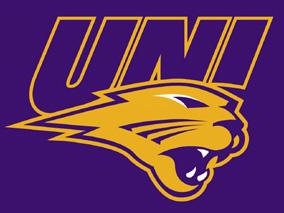


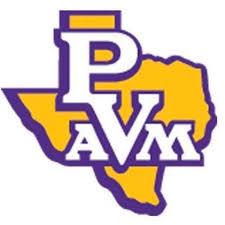


4 University of Alabama dominates Wisconsin in Madison, 42-10
The Crimson Tide traveled to Wisconsin and handed the Badgers their first loss of the season. Former Washington coach Kalen DeBoer is 3-0 at the University of Alabama thanks to 226 passing yards and six touchdowns from his offense, and a defense that forced four fumbles and held the Badgers to one touchdown.
No. 17 Michigan recovers with narrow 28-18 win over Arkansas State University
After suffering their first loss in over a year, the Wolverines came in hot as they jumped to a 28-3 lead early in the fourth quarter. No one knows better than Michigan alumnus Tom Brady that even a 28-3 game isn’t over until the clock hits zero. The Red Wolves began mounting a comeback in the final quarter, but were only able to come within ten points as the Wolverines stood strong enough to finish off the win.















By BECK PARSONS Sports Reporter
Big Ten quarterbacks must face famously tough defenses, making a good quarterback especially vital. With Big Ten matchups slowly getting underway, now is a good time to rank the Big Ten’s five best quarterbacks.
Two games: 607 passing yards, 72.7% completion percentage, 2 touchdowns, 0 interceptions
Moss spent the last two years sitting behind last year’s first overall draft pick, Caleb Williams. When Williams sat out the 2023 Holiday Bowl to prepare for the draft, Moss stepped in, throwing for 372 yards and six touchdowns in a 42-28 win over the University of Louisville. In his two regular-season games as a starter, Moss has continued to impress, throwing for 607 yards and two touchdowns in wins over Utah State University and No. 13-ranked Louisiana State University. He’ll need to score more touchdowns to truly wow analysts, but he’s got time. Moss already has five pass-catchers averaging more than 15 yards per reception.
Rourke, University of Indiana
Three games: 755 passing yards, 74.3% completion percentage, 7 touchdowns, 0 interceptions
Rourke spent his last five years with the University of Ohio but has quietly excelled since becoming a Hoosier. He leads the Big Ten in passing touchdowns with seven scores. His yards per attempt (10.2) and efficiency rating (191.2) are second only to Allar, while his passing yards (755) and completion percentage (74.3%) rank third behind only Gabriel and Rogers. Rourke has found a weapon in sophomore wide receiver Omar Cooper Jr., who has 234 receiving yards and two touchdowns on just eleven catches. Indiana is already 1-0 in the Big Ten and may break more hearts during conference play.
Three games: 825 passing yards, 77.1% completion percentage, 6 touchdowns, 0 interceptions
Rogers transferred to Washington this offseason after setting 30 program records in a four-year career at Mississippi State University. Rogers, who holds the SEC record for all-time completions and shined under Mike Leach’s “air raid” offense, looks to have adjusted well to his new home. After three games with the Huskies, Rogers sits second only to Gabriel in passing yards (825) and completion percentage (77.1%). He’s connected well with senior receiver Giles Jackson, whose 24 receptions and 326 receiving yards are both second in the Big Ten behind Maryland’s Tai Felton.
Two games: completion percentage, interception
Allar has only played two games but has outplayed both his stat line and his opponents. Allar has an efficiency rating of 199.4 and is averaging 11.4 yards per attempt, both of which lead the Big Ten. His role inside Penn State’s run-heavy scheme will limit his statistical production to some extent, but there’s a reason many analysts believe Allar to have the greatest professional potential of any of the Big Ten’s veteran quarterbacks.
Three games: yards, percentage, interceptions
Through three weeks, Gabriel leads the Big Ten in passing yards (914), passing yards per game (305) and completion percentage (84%). His six touchdown passes are tied for the conference’s secondmost. Following two solid weeks against the University of Idaho and Boise State University, Gabriel delivered the kind of dominant performance against Oregon State University that many fans were expecting to see immediately. Given the receiving weapons Gabriel has at his disposal, Ducks fans have plenty to feel optimistic about.

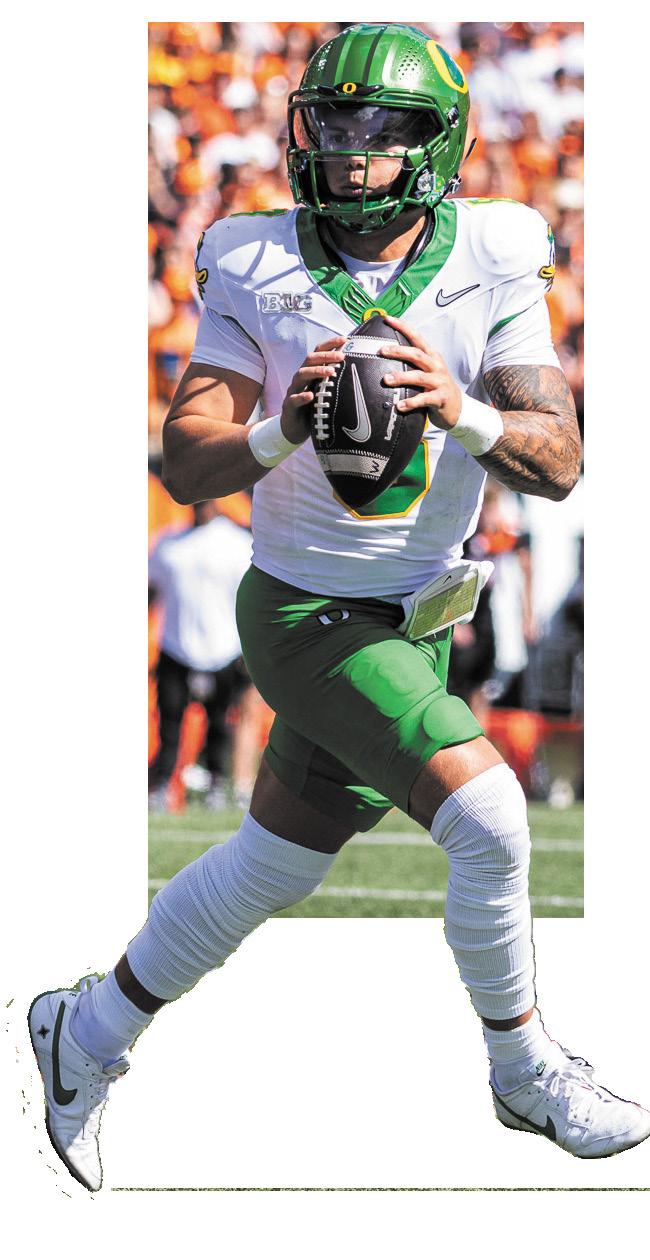
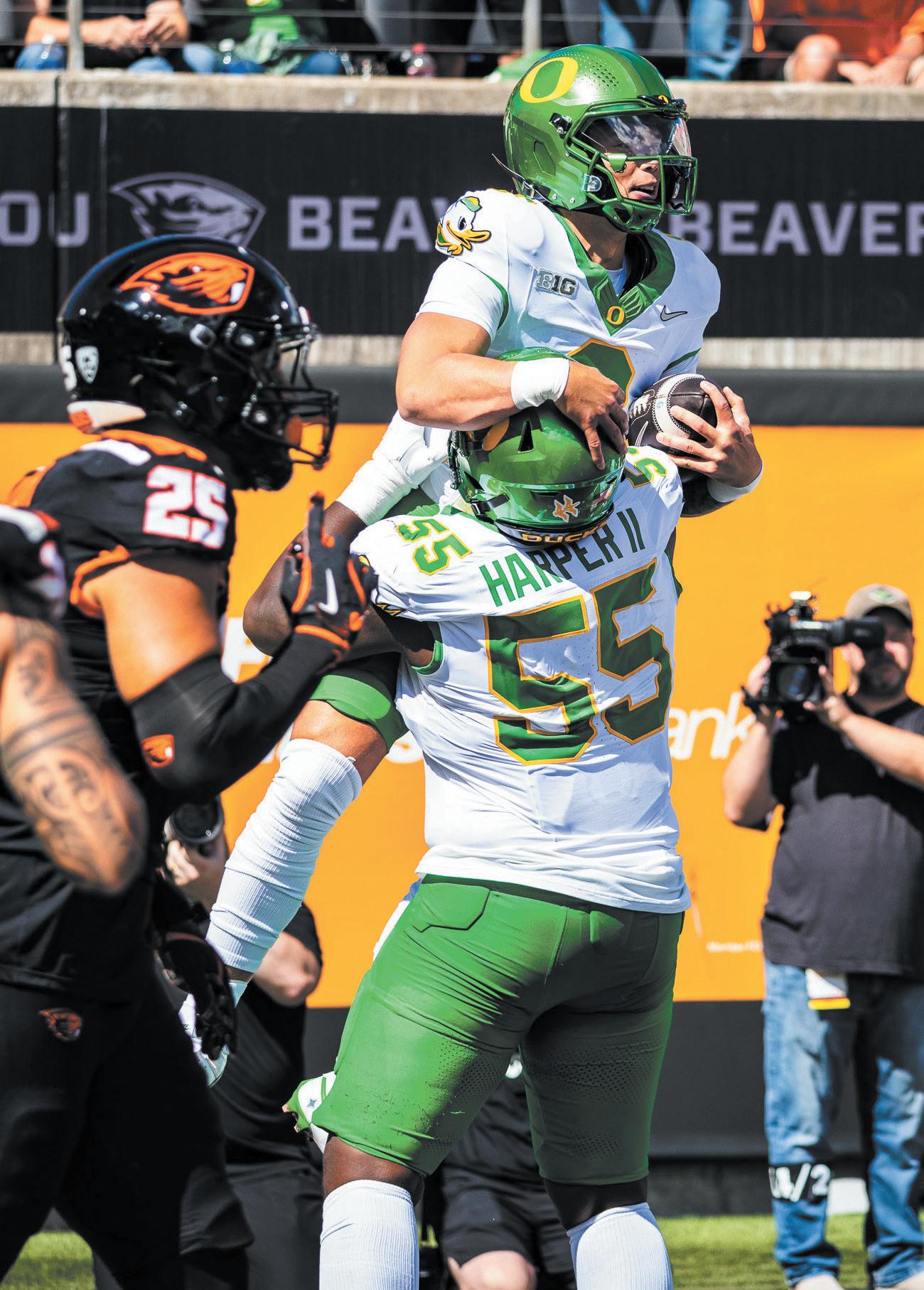
By JOE KRASNOWSKI Sports Reporter
The Ducks wanted to be the villains this season. To start off the non-conference slate on fire seemed like a logical route for the team that dominated the transfer portal. But for most of their three non-Big Ten games, they looked like the type of antagonists that spoil their own plans with silly mistakes.
Against Idaho State in Week 1, the offense was clunky and disjointed.
Facing Boise State in Week 2, the Broncos were a few special teams touchdowns away from a massive upset.
Still, despite the lessthan-ideal execution, the Ducks have enjoyed a few familiar hallmarks regardless of their unexpectedly slow start.
Lanning’s squad is still 3-0.
They are still a frontrunner in the College Football Playoff Race.
And aside from a few moments, the Ducks’ stars have looked the part with Dillon Gabriel and Tez Johnson leading the way.
But, it’s important to note that Oregon has been far from perfect. In fact, two of the three games during the first slate of action showed numerous ways that this Ducks team might fall flat of its lofty expectations.
Back-to-back games against inferior opposition from the state of Idaho exposed a collection of potential flaws, including an offensive line that was advertised as one of the nation’s best moreclosely resembling a colander.
However, it may be no more than a brief slump that seems to have reached an end with the Ducks’ strong second-half play against Oregon State. Going forward into a Big Ten slate, more of what the Ducks showed in the second half against Oregon State will be imperative. The Ducks outgained the Beavers 329 to 91 in the second half alone, outscoring OSU 29-0 in the process.
be. Illinois is nationally ranked and just defeated a then-ranked Kansas team. Not to mention, a regularseason finale showdown is slated with the Huskies, who recently seem to have the Ducks’ number.
Road tests against both Michigan and Wisconsin still await Oregon, and both provide new, loud and cold settings looking to envelop the newcomer Ducks with a stiff welcome.
Although neither of them have showcased exceptionally strong play, with each squad toting a
looking to break green-and-yellow-clad hearts. MSU’s head coach Jonathan Smith will be a familiar foe after his many seasons at the helm at Oregon State.
Additionally, Oregon’s been susceptible to road losses against significantly inferior teams, and will have to battle those demons against both UCLA and Purdue on the road. If there were ever opportunities for the Ducks to suffer a huge let-down, those two matchups provide ample opportunity.
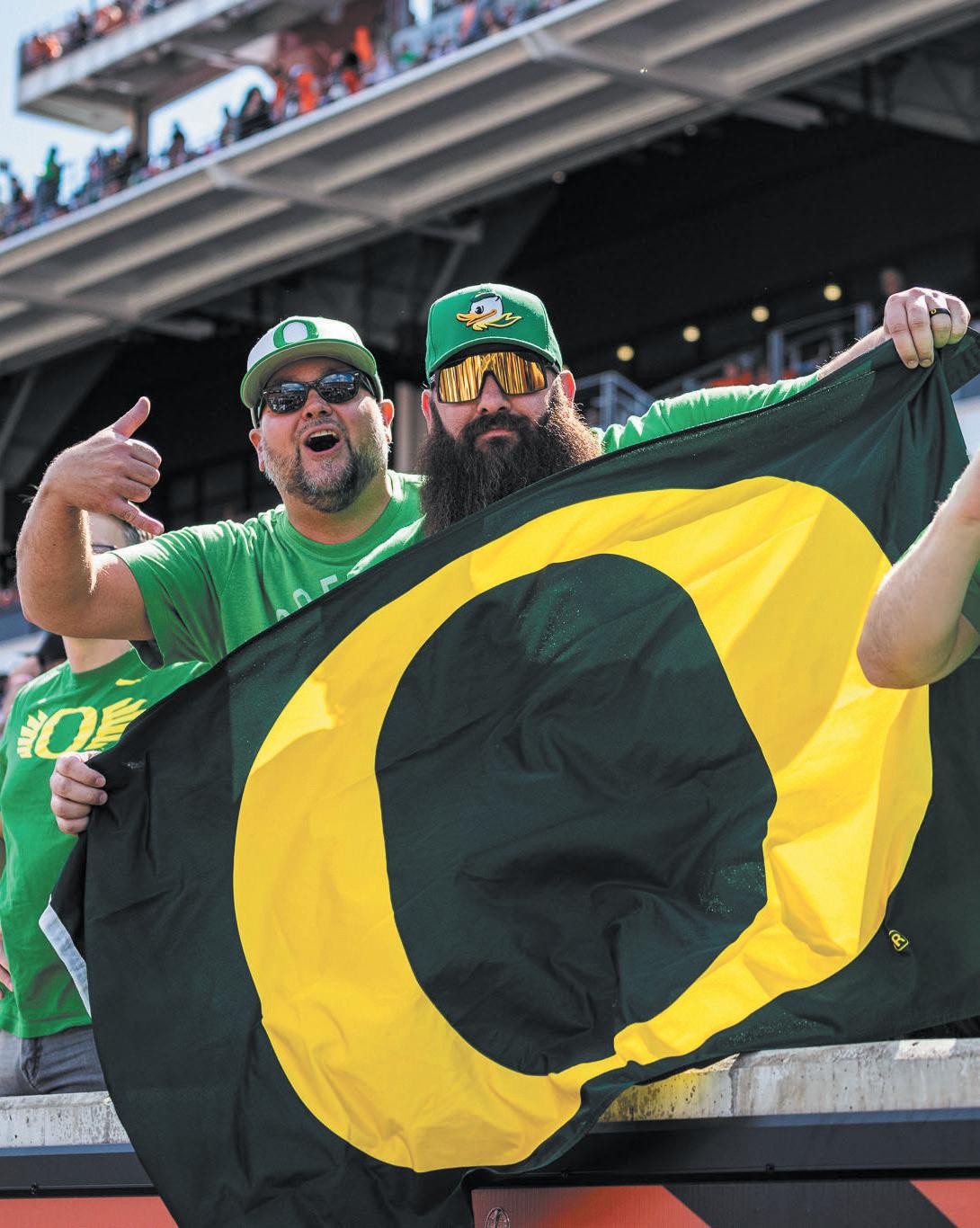
“I would love to tell you but then the Krabby Patty secret formula is out,” Gabriel said about what changed for the Ducks with a laugh.
Such strong play will be necessitated by the Ducks’ schedule going forward.
Ohio State looks every bit like the National Championship contender they were expected to
loss against a top-tier team. It’s essential the Ducks take their experienced squad head-on — even relying on their Big Ten transfers for help.
“Some of these guys, of course, are asking me about playing in the Big Ten,” offensive lineman Matthew Bedford, who played in the Big Ten at Indiana, said.
Upset possibilities loom as Illinois and Michigan State — both of whom have exceeded expectations in the early season — will storm into Autzen Stadium
The Bruins will be a week removed from a matchup with LSU that will likely highlight their many flaws. Oregon will be coming off a bye, looking to roll over their subpar opponent.
But failure to execute may revive the drama the first two weeks of play had to offer.
What’s more, when the Ducks travel to Purdue in Week 8, they will be just six days removed from the showdown with Ohio State and its many stars. Quarterback Will Howard, running back Quinshon Judkins and defensive back Caleb Downs headline the Buckeyes in a matchup that fans have had circled for weeks.
A new conference creates new opportunities along with new challenges. Still, if the Ducks perform like they did in the second half against the Beavers — their remaining schedule shouldn’t be too much to bear.
Perhaps most importantly, the continuation of Gabriel’s Heismancaliber play will help.
He connected on 20 of his 24 passes Saturday afternoon behind Oregon’s offensive line’s best showing of the season, improving his season competition percentage to a nationally-best 84 %.
“I always tell the O-Line ‘If you give me the time, I’ll do the crime,’” Gabriel said. And no stranger to big wins amid a long season, he certainly knows what comes.
“We’ll continue to make adjustments, and that doesn’t stop, but of course you find the formula for your group and keeping building off of it,” Gabriel said.
After the conclusion of Week 2 of the NFL season, we’re taking a look at the highest
(Molly McPherson/Emerald)

By JACK LAZARUS Sports Associate Editor
success unheard of in Detroit since Sewell’s selection in the first round
Over the course of three seasons Holland became the entire nucleus of the Dolphins’ defense. As a safety, Holland has been able to affect the game in a variety of ways. While his eight total tackles and pass defense are nothing to bat an eye at, it was his forced fumble Week 1 against the Jaguars that proved his most impressive highlight. With running back Travis Etienne almost at the goal line for a score, Holland sprung toward the ball and punched it right out of his hands, preventing a score that would have taken the Dolphins
Thibodeaux hasn’t had the most electric start to his third season, tallying just four total tackles, only one tackle for loss and three QB hits. New York struggled in the first two games, falling to 0-2 largely behind the deficiencies in the offense. Thibodeaux will make his impact more as the season goes on, and hopes to match his excellent sack
A captain for the Colts, Buckner dominated the trenches in a close Week 1 loss against the Houston Texans, with six total tackles, one for loss, 1.5 sacks and two QB hits. Buckner slowed down during Week 2 in Green Bay, but his presence has been felt this season. Buckner hasn’t tallied under 7.0 sacks since the 2017 season, and is still on pace to achieve success in that realm this







Oregon football struggled to separate early in the season — but it’s getting better. Why? It’s all in the “middle eight.”

By OWEN MURRAY Sports Reporter
Legendary USC and Seattle Seahawks coach Pete Carroll often said that you can only win the game in the fourth quarter.
He’s right, but that doesn’t mean that the other three quarters don’t matter. For Oregon head coach Dan Lanning, there’s another important period.
“We had the ball twice before the half and we didn’t score,” Lanning said after the Ducks’ 24-14 win over Idaho. “We had an opportunity to kick [a field goal] — didn’t make the kick — didn’t score in the middle eight. Generally that’s something that we’ve done well.”
The “middle eight” Lanning refers to is the final four minutes of the second quarter combined with the first four minutes of the third quarter. A score either immediately before or after the half seizes momentum for the team — especially if it’s a vital gain.
In 2023, the Ducks scored within the “middle eight” in all but one game — at Utah, where they were already leading 21-6 at halftime.
In the first of Oregon’s two losses to the Washington Huskies last season, the Ducks scored a field goal with 2:04 left on the clock before the half — but after intercepting Michael Penix with 55 seconds to run and driving to the 3-yard line, they eschewed a second kick and subsequently failed a 4th-down
rushing effort. The Ducks lost the game by three points.
A score in the middle eight does not guarantee a win. In the Ducks’ second loss to the Huskies in the Pac-12 Championship, Bo Nix led a 90-second, 75-yard touchdown drive that left Washington with just nine seconds on the clock. Oregon even held the Huskies scoreless in the third quarter, but Carroll would be proud of them — Washington won that game in the fourth.
Issues in the middle eight are what plagued the Ducks in their Week 1 win over Idaho. It didn’t matter that a stout Oregon defense held the Vandals scoreless in the first half. An offense that couldn’t finish drives fumbled and then couldn’t move downfield in a two-minute scenario to end the half. After the break, the Ducks continued to sputter — back-to-back drives produced a three-and-out and a turnover on downs.
“It’s something that we want to be really good at — we talk about the middle eight all the time,” Lanning said after a fall practice. “Just being able to score at the end of the half and potentially start with the ball in the second half and a good drive is something that we want to be good at, but it’s a good thing for us to improve right now.”
The Ducks struggled to separate once again with Boise State in Week 2 — even if it got a little better. Dillon Gabriel tossed a one-play touchdown to Evan Stewart with 9:28 left in the second quarter. From
there? Three drives went punt, punt, kneel down. Gabriel found Traeshon Holden on a slant that went 59-yards to the house with 9:09 left in the third, but even that only tied the game.
“I remember vividly, there was a time in the Boise game where we emphasized, ‘Let’s win the middle eight,’” Oregon offensive lineman Marcus Harper II said. “We didn’t have the ball coming out of the half, but you can widen the gap in the game if you win the middle eight.”
Against Oregon State, the Ducks improved again. Despite possessing the ball for just 8:59 in the first half, they scored three times before the break, including a third touchdown just outside the middle eight. If not for a controversial roughing-the-passer penalty that handed the Beavers their 1st-and-goal, Oregon likely would’ve won the period.
With the conference schedule ahead of them, it’ll be the middle eight that allows the Ducks to pull away from opponents and gain slight advantages over others. It’ll be one of a few places where — although they can’t win the game — they’ll be able to seize control.
HOW ABOUT THAT, PETE?


















By Brady Ruth Sports Editor
As it turns out, Oregon State’s offseason mass exodus was a sign of things to come. Reser Stadium rapidly emptied out in a similar fashion as the Ducks took a 49-14 lead in the fourth quarter.
Four quarters of complete and utter domination gave way to No. 9 Oregon’s (3-0) blowout win over its in-state rival. Yet, the game’s two halves looked distinctly different despite the Ducks’ offense’s consistent production.
In the first half, the contest’s two offenses went blow-for-blow in their own unique ways. The Beavers’ methodically moved the ball down the field with several long, time-consuming drives that saw Oregon State convert six-of-nine 3rd downs to put up 14 points. Because of this, the Ducks rarely got the football. In fact, Oregon ran just nine plays in the first quarter compared to OSU’s 23.
So, the Ducks had to make their limited time count. Remarkably, they were able to do so, manufacturing three touchdown drives that never used more than four minutes, the longest of which used just three minutes and 52 seconds.
Oregon relied on the explosive plays that head coach Dan Lanning had been calling for over the
How the Ducks’ defense took all the suspense out of Oregon’s 49-14 win over the Beavers
past few weeks. Big completions to the three-headed monster of Tez Johnson, Evan Stewart and Traeshon Holden led the charge as Dillon Gabriel worked a perfect 10-10 first half with 114 yards and both a rushing and passing touchdown.
Oregon went into the locker room at halftime with a 22-14 lead despite only possessing the ball for just under nine of the half’s 30 minutes. But it just didn’t feel sustainable. There was this looming sense in Reser Stadium that if the Oregon offense stalled and the Beavers could continue to dominate the clock, the Ducks could end up in an uncomfortable situation.
But something changed in that Ducks’ locker room at the break. Oregon’s defense came out with a newfound dominance, and the offense didn’t have to trade efficiency for effectiveness.
In fact, the Ducks’ opening drive in the second half was their longest of the day at 4:35 (which is still an absurdly low number) and continued the momentum that they’d built in the first half. The rest of the game offensively became rhythmic for Oregon. The next three drives resulted in touchdowns, then a field goal, then Dante Moore kneeled the clock out. That 3rd down chainsaw that the Beavers love to flex only sounded six times, and Oregon converted on four of them.
The difference between the two halves was strictly
on the defensive side of the ball.
Oregon limited the Beavers to a measly 91 total yards of offense in the second half while forcing 145 yards worth of punts. Oregon State couldn’t remotely move the ball, and its powerful run game that was supposed to run down the Oregon defense accumulated just 15 rushing yards in the final 30 minutes of play.
“We avoided the explosive plays on defense,” Lanning said. “I think if you want to talk about a big mark, for us defensively the last couple of weeks we’ve had some explosive plays given up. We didn’t see that today.”
Oh, and that 6-9 that Oregon State was on 3rd down in the first half? That became 1-6 in the final 30 minutes of play. The Beavers’ ability to move the ball and land timely conversions disappeared just as fast as the OSU student section as it read the writing on the wall.
“We really, more than anything, talked about getting stops on 3rd down,” Lanning said. “To equate to stops on 3rd down, it meant winning 1st and 2nd down defensively.
Now, the Ducks are riding high into their first bye week of the season and have a chance to build on their momentum as conference play approaches.

